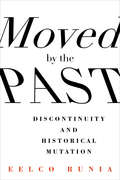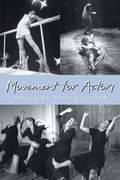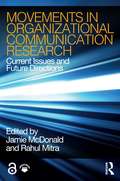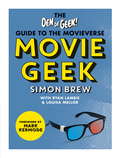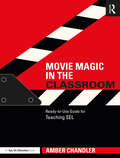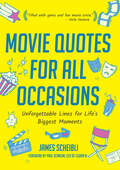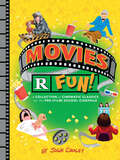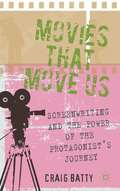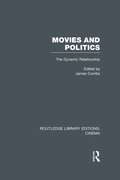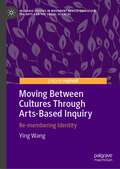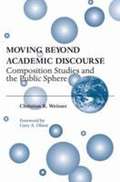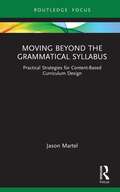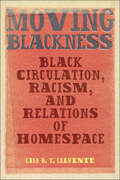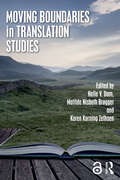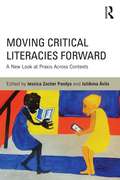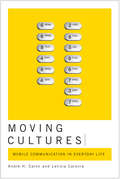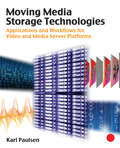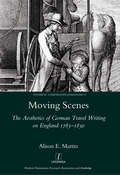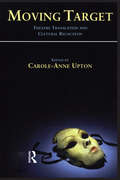- Table View
- List View
Moved by the Past: Discontinuity and Historical Mutation (European Perspectives: A Series in Social Thought and Cultural Criticism)
by Eelco RuniaHistorians go to great lengths to avoid confronting discontinuity, searching for explanations as to why such events as the fall of the Berlin Wall, George W. Bush's invasion of Iraq, and the introduction of the euro logically develop from what came before. Moved by the Past radically breaks with this tradition of predating the past, incites us to fully acknowledge the discontinuous nature of discontinuities, and proposes to use the fact that history is propelled by unforeseeable leaps and bounds as a starting point for a truly evolutionary conception of history. Integrating research from a variety of disciplines, Eelco Runia identifies two modes of being "moved by the past": regressive and revolutionary. In the regressive mode, the past may either overwhelm us—as in nostalgia—or provoke us to act out what we believe to be solidly dead. When we are moved by the past in a revolutionary sense, we may be said to embody history: we burn our bridges behind us and create accomplished facts we have no choice but to live up to. In the final thesis of Moved by the Past, humans energize their own evolution by habitually creating situations ("catastrophes" or sublime historical events) that put a premium on mutations. This book therefore illuminates how every now and then we chase ourselves away from what we were and force ourselves to become what we are. Proposing a simple yet radical change in perspective, Runia profoundly reorients how we think and theorize about history.
Movement for Actors
by Nicole PotterTeachers and practitioners offer actors, directors, and students both practical suggestions and inspiration on how to tell the story through the body. Body basics, beyond glove and fan, and schools of thought are among the themes.
Movements in Organizational Communication Research: Current Issues and Future Directions
by Jamie McDonald Rahul MitraMovements in Organizational Communication Research is an essential resource for anyone wishing to become familiar with the current state of organizational communication research and key trends in the field. Seasoned organizational communication scholars will find that the book provides unique insights by way of the intergenerational dialogue that is found in the book, as well as the contributors’ stories about their scholarly trajectories. Those who are new to the field will find that the book enables them to familiarize themselves with the field and become a part of the organizational communication scholarly community in an inviting and accessible way. Key features of the book include: A review of current issues and future directions in 13 topical areas of organizational communication research. Intergenerational dialogue and collaboration between both established and emerging scholars in their specialty areas. Reflections by the authors on their scholarly trajectories and how they became a part of the field. Discussion questions at the end of each chapter that prompt reflections and debate. The book also features online resources for instructors: Sample course syllabus Suggested case studies from the book Cases in Organization and Managerial Communication to align with this book’s chapters The book is recommended as the anchor text for introductory graduate-level courses and upper-level undergraduate courses in organizational communication. It is also an excellent supplementary text for advanced doctoral-level courses in organizational communication, and courses in related fields such as organization studies, organizational behavior, and management.
Movie Geek: The Den of Geek Guide to the Movieverse
by Simon Brew Den Of GeekMovie Geek is a nerdy dive into popular movies, brought to you by the award-losing Den Of Geek website, with a foreword by the UK's foremost film critic, Mark Kermode. Discover hidden stories behind movies you love (and, er, don't love so much), and find out just why the most dangerous place to be is in a Tom Hanks film.Fascinating, surprisingly and hugely entertaining, this leftfield movie guide is gold for film buffs, and might just bring out the geek - hidden or otherwise - within you...Includes:Alternative movie endings that were binned Movie sequels you didn't know existedMassive box office hits that were huge gamblesThe collateral damage of Tom Hanks moviesHidden subtexts in family moviesDisastrous things that went wrong on modern movie sets...and much, much more!
Movie Geek: The Den of Geek Guide to the Movieverse
by Simon Brew Den of GeekA comprehensive compendium of cult website Den of Geek's most popular articles combined with new material to create the ultimate alternative encyclopedia of film.
Movie Magic in the Classroom: Ready-to-Use Guide for Teaching SEL
by Amber ChandlerMovies belong in the curriculum—and not just the day before a holiday. This book by award-winning educator Amber Chandler shows why films are so important for teaching social emotional learning and critical thinking. She provides complete guides to ten current, age-appropriate movies; each guide features a pre-viewing activity, a stop-and-chat guide for you so you know when to pause for discussion, a student notes sheet, and discussion questions with varying formats. The book also offers handy tools such as blank templates and permissions forms for communication with parents.Every movie addresses some aspects of CASEL’s SEL Competencies: Self-Awareness, Self-Management, Responsible Decision-Making, Relationship Skills, and Social Awareness. Amber Chandler does all the prep work for you, so you can lean into the movie experience and share this opportunity with your students, putting movie magic to work!
Movie Quotes for All Occasions: Unforgettable Lines for Life's Biggest Moments
by James ScheibliFind a film quotation for any situation in this collection that’s “full of gems” (Varla Ventura, author of The Book of the Bizarre).From Rhett Butler to Obi-Wan Kenobi, movie quotes have become an integral part of the way we express ourselves. This book gathers great lines with a purpose in mind: finding the right words to toast, celebrate, motivate, or comfort during the important occasions in our lives—whether it’s a wedding, a big game, a memorial service, a graduation, or a workplace event.Moving, inspiring, or just plain funny, you’ll find lots of options—or you can just enjoy reading—with this volume that also includes plenty of trivia and viewing suggestions for movie lovers.
Movies R Fun!: A Collection of Cinematic Classics for the Pre-(Film) School Cinephile
by Josh CooleyNo one under seventeen should be admitted without a parent or guardian to these “fun-filled” illustrations of twisted movie moments from a beloved animator (Parade).Let’s face it, reading sucks . . . but movies are fun! In this grown-up parody of a children’s picture book, Pixar writer and artist Josh Cooley presents the most hilariously inappropriate—that is, the best—scenes from contemporary classic films in an illustrated, for-early-readers style. Terrifying, sexy, and awesome scenes from such favorite films as Alien, Rosemary’s Baby, Fargo, Basic Instinct, Seven, The Silence of the Lambs, Apocalypse Now, The Shining, and many more are playfully illustrated and captioned to make reading fun and exciting for kids who never grew up. A sly celebration of the things fans love most about these legendary films (and movies in general), this is one book that probably should not be read at bedtime.
Movies That Move Us
by Craig BattyFrom a screenwriting perspective, Batty explores the idea that the protagonist's journey is comprised of two individual yet interwoven threads: the physical journey and the emotional journey. His analysis includes detailed case studies of the films Muriel's Wedding , Little Voice , Cars , Forgetting Sarah Marshall , Sunshine Cleaning and Up.
Movies and Politics: The Dynamic Relationship (Routledge Library Editions: Cinema)
by James CombsCollecting together some of the best thinking about the relationship between movies and politics, this book, originally published in 1993, encourages an awareness of the political dimension of film, both for film scholars and those entering the film industry. Eight essays are grouped into four parts addressing political ideology and movie narrative, political myth in the movies, political history and movie culture, and political communication and the movies. An introductory essay, as well as prefatory remarks to each of the four parts, brings additional insight and perspective and puts the essays into context.
Moving Between Cultures Through Arts-Based Inquiry: Re-membering Identity (Palgrave Studies in Movement across Education, the Arts and the Social Sciences)
by Ying WangThis book is an exploration of the concept of in-betweenness, as it occurs within the process of moving between the author’s root culture and adopted culture, from her perspective as an immigrant creative arts therapist. Through the critical autoethnographic voice and a/r/tographic inquiry, she introduces a unique exploration site within the process of Guqin-making, an ancient Chinese art form. Through the creation of images and poetry, and through Guqin-making and music-making/playing, the book expands the discussion of in-betweenness by re-theorising ancient Chinese philosophical perspectives on harmonic space. This contribution to arts-based research provides a unique standpoint to explore research methods of moving, walking, making, resting and awakening. It showcases how other researchers can transfer the invisible and intangible embodied feelings, memories and emotions arising from moving between two or more cultures into visible and tangible images, narrative, poetry, craft and music-playing to conduct powerful, interdisciplinary arts-based research.
Moving Beyond Academic Discourse: Composition Studies And The Public Sphere
by Christian R. WeisserMoving student writing beyond academic discourse and into larger public spheres is a difficult task, but Christian R. Weisser’s study challenges composition instructors to do just that. This highly accessible book does what no other study has attempted to do: place the most current, cutting-edge theories and pedagogies in rhetoric and composition in their intellectual and historical contexts, while at the same time offering a unique, practical theory and pedagogy of public writing for use both inside and outside of the classroom. By positing a theory of the public for composition studies, one which envisions the public sphere as a highly contested, historically textured, multilayered, and sometimes contradictory site, Weisser offers a new approach to the roles that compositionists might assume in their attempts to initiate progressive political and social change. After first providing a historical context that situates composition’s recent interest in public writing, Weisser next examines recent theories in composition studies that consider writing an act of social engagement before outlining a more complex theory of the public based on the work of Jürgen Habermas. The resulting re-envisioning of the public sphere expands current conversations in rhetoric and composition concerning the public. Weisser concludes with a holistic vision that places greater political and social import on addressing public issues and conversations in the composition classroom and that elucidates the role of the public intellectual as it relates specifically to compositionists in postmodern society.
Moving Beyond the Grammatical Syllabus: Practical Strategies for Content-Based Curriculum Design (Routledge Focus on Applied Linguistics)
by Jason MartelIn this concise and practical book, Martel advocates for a content-based approach to foreign language curriculum design that emphasizes communicative competence, cognitive engagement, and social justice. Intended primarily for busy teachers with limited preparation time, the book includes: An introduction to content-based instruction and its use to date in foreign language education Step-by-step strategies for designing content-based unit plans, lesson plans, and assessments A complete curricular unit that serves as a guiding example, including nine lesson plans and a summative assessment The book is accompanied by a website that will feature additional examples of content-based curricular materials across a range of languages and proficiency levels, available at http://cbi.middcreate.net/movingbeyond.
Moving Blackness: Black Circulation, Racism, and Relations of Homespace
by Lisa B. CalventeMoving Blackness: Black Circulation, Racism, and Relations of Homespace delves into the intricate connections between communication, culture, power, and racism in relation to blackness. Through a blend of interviews, oral histories, and meticulous archival research, this book sheds light on the multifaceted narratives surrounding Black identity. It explores how these stories circulate, serving as tools of resistance, negotiation, and affirmation of diverse manifestations and representations of blackness. By emphasizing the significance of storytelling as a means through which blackness affirms itself, transcending time and space, the book underscores how communicative embodiments of Black identity enable individuals to persevere within marginalized contexts. Engaging with theories of anti-Black racism, modernity, coloniality, and the Black diaspora, the book frames storytelling and the circulation of narratives as performances deeply rooted in the everyday lives of Black people across the diaspora. Starting with an examination of the racial construction of movement during colonialism and slavery, the book traces how this history shapes contemporary interactions. With its exploration of how Black circulation transforms movement and space, the book introduces a forward-thinking approach to the Black diaspora, anchored in a politics of identification rather than being confined to the past or a specific location. Moving Blackness argues that the desire for homespace, a yearning for belonging that transcends any particular physical space, fuels this envisioned future, rooted in the historical and material conditions of racism and marginalization.
Moving Boundaries in Translation Studies
by Helle V. Dam Matilde Nisbeth Brøgger Karen Korning ZethsenTranslation is in motion. Technological developments, digitalisation and globalisation are among the many factors affecting and changing translation and, with it, translation studies. Moving Boundaries in Translation Studies offers a bird’s-eye view of recent developments and discusses their implications for the boundaries of the discipline. With 15 chapters written by leading translation scholars from around the world, the book analyses new translation phenomena, new practices and tools, new forms of organisation, new concepts and names as well as new scholarly approaches and methods. This is key reading for scholars, researchers and advanced students of translation and interpreting studies.
Moving Critical Literacies Forward: A New Look at Praxis Across Contexts
by Jessica Pandya JuliAnna ÁvilaTaking the pulse of current efforts to do—and, in some cases, undo—critical literacy, this volume explores and critiques its implementation in learning contexts around the globe. An impressive set of international authors offer examples of productive critical literacy practices in and out of schools, address the tensions and gaps between these practices and educational policies, and attempt to forecast the future for critical literacy as a movement in the changing global educational policy landscape. This collection is unique in presenting the recent work of luminaries such as Allan Luke and Hilary Janks alongside relative newcomers who use innovative approaches and arguments to reinvigorate and redefine critical practice. It is time for this cutting-edge inquiry into the state of critical literacy—not only because is it a complex and ever-evolving field, but perhaps more important, because it offers a reaction to, and powerful reworking of, standardization and high-stakes accountability measures in educational contexts around the globe.
Moving Cultures
by Letizia Caronia André H. CaronAndré Caron and Letizia Caronia look at teenagers' use of text messaging to chat, flirt, and gossip. They find that messaging among teens has little to do with sending shorthand information quickly. Instead, it is a verbal performance through which young people create culture. Moving Cultures argues that teenagers have domesticated and reinterpreted this technology.
Moving From Spoken to Written Language With ELLs
by Ivannia SotoMastering spoken language is the key to writing success for English language learners English language learners struggle to meet the increased classroom writing demands of the Common Core State Standards, and many schools seem at a loss for solutions. In these pages, ELL expert Ivannia Soto builds on the groundbreaking research she presented in her previous book ELL Shadowing as a Catalyst for Change to show how oral language development scaffolds writing skills. To implement this knowledge, Soto offers educators a powerful set of tools: • Exciting spoken techniques such as Socratic Seminar, Frayer model and Think-Pair-Share that build vocabulary and extend into academic writing • Approaches to teaching three essential styles of writing: argumentative, procedural, and narrative • Sample lesson plans and graphic organizer templates ELLs must develop oral language skills before meeting the Common Core’s writing requirements. This book provides the tools to make this happen. "This timely book collects oral language strategies designed to scaffold academic writing for English language learners at intermediate and advanced levels of English proficiency. Concrete examples support the goal of teaching college and career ready standards across content areas." —Charlene Rivera, Research Professor The George Washington University Center for Equity and Excellence in Education
Moving From Spoken to Written Language With ELLs
by Ivannia SotoMastering spoken language is the key to writing success for English language learners English language learners struggle to meet the increased classroom writing demands of the Common Core State Standards, and many schools seem at a loss for solutions. In these pages, ELL expert Ivannia Soto builds on the groundbreaking research she presented in her previous book ELL Shadowing as a Catalyst for Change to show how oral language development scaffolds writing skills. To implement this knowledge, Soto offers educators a powerful set of tools: • Exciting spoken techniques such as Socratic Seminar, Frayer model and Think-Pair-Share that build vocabulary and extend into academic writing • Approaches to teaching three essential styles of writing: argumentative, procedural, and narrative • Sample lesson plans and graphic organizer templates ELLs must develop oral language skills before meeting the Common Core’s writing requirements. This book provides the tools to make this happen. "This timely book collects oral language strategies designed to scaffold academic writing for English language learners at intermediate and advanced levels of English proficiency. Concrete examples support the goal of teaching college and career ready standards across content areas." —Charlene Rivera, Research Professor The George Washington University Center for Equity and Excellence in Education
Moving Home: Gender, Place, and Travel Writing in the Early Black Atlantic (Next Wave: New Directions in Women's Studies)
by Sandra GunningIn Moving Home, Sandra Gunning examines nineteenth-century African diasporic travel writing to expand and complicate understandings of the Black Atlantic. Gunning draws on the writing of missionaries, abolitionists, entrepreneurs, and explorers whose work challenges the assumptions that travel writing is primarily associated with leisure or scientific research. For instance, Yoruba ex-slave turned Anglican bishop Samuel Ajayi Crowther played a role in the Christianization of colonial Nigeria. Sarah Forbes Bonetta, a formerly enslaved girl "gifted" to Queen Victoria, traveled the African colonies as the wife of a prominent colonial figure and under the protection of her benefactress. Alongside Nancy Gardiner Prince, Martin R. Delany, Robert Campbell, and others, these writers used their mobility as African diasporic and colonial subjects to explore the Atlantic world and beyond while they negotiated the complex intersections between nation and empire. Rather than categorizing them as merely precursors of Pan-Africanist traditions, Gunning traces their successes and frustrations to capture a sense of the historical and geographical specificities that shaped their careers.
Moving Media Storage Technologies: Applications & Workflows for Video and Media Server Platforms
by Karl PaulsenComplex media storage computer systems are employed by broadcasters, digital cinemas, digital signage, and other business and entertainment venues to capture, store and retrieve moving media content on systems that will preserve the original integrity of the content over time and technological transition. This book provides detailed information related to the concepts, applications, implementation and interfaces of video file servers, intelligent storage systems, media asset management services, content distribution networks, and mission critical platforms. A tutorial and case example approach is taken to facilitate a thorough understanding of the technologies, using numerous illustrations, tables and examples. The text and appendices are designed to provide easy to access valuable reference and historical information. .A focus on the media serving concepts and principles employed at the enterprise level .Practical and technological summaries of the applications and linkages between media asset management and storage technologies for studio, television, and media production workflows .Illustrations, standards, tables, and practical summaries serve as handy reference tools
Moving On
by Della GaltonYou are writing and selling short stories but you want to take the next step and write a novel. Della Galton, author of the successful writing guide How To Write and Sell Short Stories, shows you how to make the leap in this step-by-step guide. Using examples from her own successful career as writer of hundreds of published short stories and two novels, Della shows the critical differences between developing character, plot and setting in short and long fiction. The essential book to help take your writing to the next level.
Moving Scenes: The Aesthetics of German Travel Writing on England 1783-1820
by Alison E. Martin"Accounts of travel to England reached unprecedented levels of popularity in the German states in the late eighteenth and early nineteenth centuries. Competition therefore increased for travel writers to produce travelogues which offered the most authentic, original and vibrant picture of England. The wider range of narrative strategies which travellers consequently deployed increasingly drew on the emotional responses of their audience - whether to serve a political purpose, show concern for the darker side to the Industrial Revolution or simply demonstrate the humanitarian interests of the travellers themselves. In this broad-ranging study, Alison E. Martin draws on a variety of travellers, men and women, canonical and forgotten, to chart the fascinating variety of styles and approaches which mark this highly interdisciplinary genre."
Moving Target: Theatre Translation and Cultural Relocation
by Carole-Anne UptonMoving Target offers a rigorous exploration of the practice of translating for the theatre. The twelve essays in the volume span a range of work from Eastern and Western Europe, Canada and the United States. For the first time, this book draws together existing translation theory with contemporary practice to shed light on a hitherto neglected aspect of the production process. How does the theatre translator mediate between source text, performance text and target audience? What happens when theatre is transposed from one culture to another? What are the obstacles to theatre translation, and what are the opportunities? Central to the debate throughout is the role of the translator in creating not only a linguistic text but also a performance text, as the contributors repeatedly demonstrate an illuminating sensibility to the demands and potential of theatre production. Impacting upon areas of (inter)cultural theory as well as theatre studies and translation studies, the result is a startling revelation of the joys, as well as the frustrations of the dramatic art of the translator for performance.
Moving Targets: Writing with Intent 1982 - 2004
by Margaret AtwoodThe companion volume to the recently reissued Second Words, Moving Targets is an essential collection of critical prose by Margaret Atwood, now available in a handsome new A List edition. The most precious treasure of this collection is that it gives us the rich back-story and diverse range of influences on Margaret Atwood’s work. From the aunts who encouraged her nascent writing career to the influence of George Orwell’s Nineteen Eighty-Four on The Handmaid’s Tale, we trace the movement of Atwood’s fertile and curious mind in action over the years.Atwood’s controversial political pieces, “Napoleon’s Two Biggest Mistakes” and “Letter to America” — both not-so-veiled warnings about the repercussions of the war in Iraq — also appear, alongside pieces that exhibit her active concern for the environment, the North, and the future of the human race. Atwood also writes about her peers: John Updike, Marina Warner, Italo Calvino, Marian Engel, Toni Morrison, Angela Carter, Gabriel Garcia Marquez, Mordecai Richler, Elmore Leonard, and Ursula Le Guin.This is a landmark volume from a major writer whose worldwide readership is in the millions, and whose work has influenced and entertained generations. Moving Targets is also the companion volume to the recently reissued Second Words.
